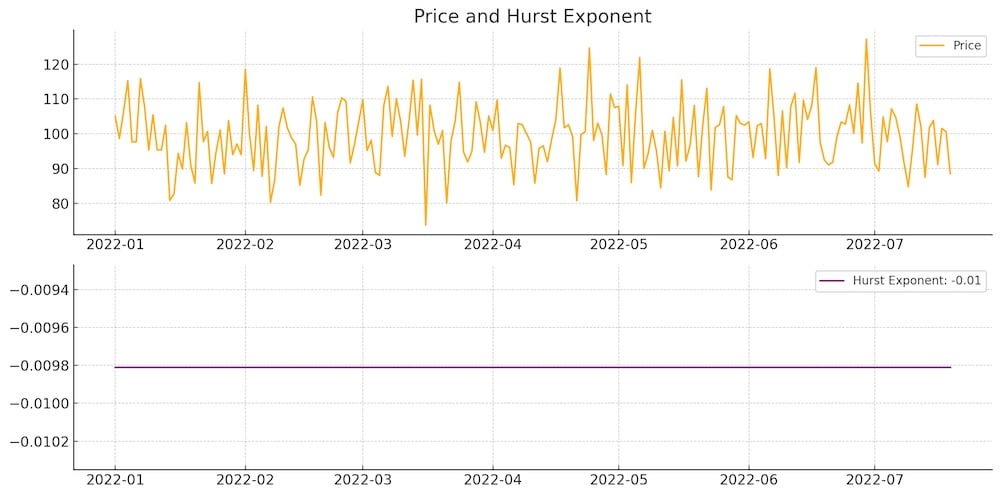In the world of investing, an economic moat is a term that has become synonymous with long-term success, largely thanks to Warren Buffett. But what exactly is an economic moat? Simply put, it’s a company’s ability to maintain competitive advantages over its rivals, ensuring sustained profitability and market dominance. Imagine a castle surrounded by a moat—it’s a barrier that keeps invaders at bay. Similarly, an economic moat protects a business from competitors, allowing it to thrive even in challenging market conditions. Buffett popularized this concept, emphasizing that companies with strong moats are more likely to deliver consistent returns over time. This idea is central to his investment strategy, guiding him to seek out businesses that can defend their market position and continue growing year after year.
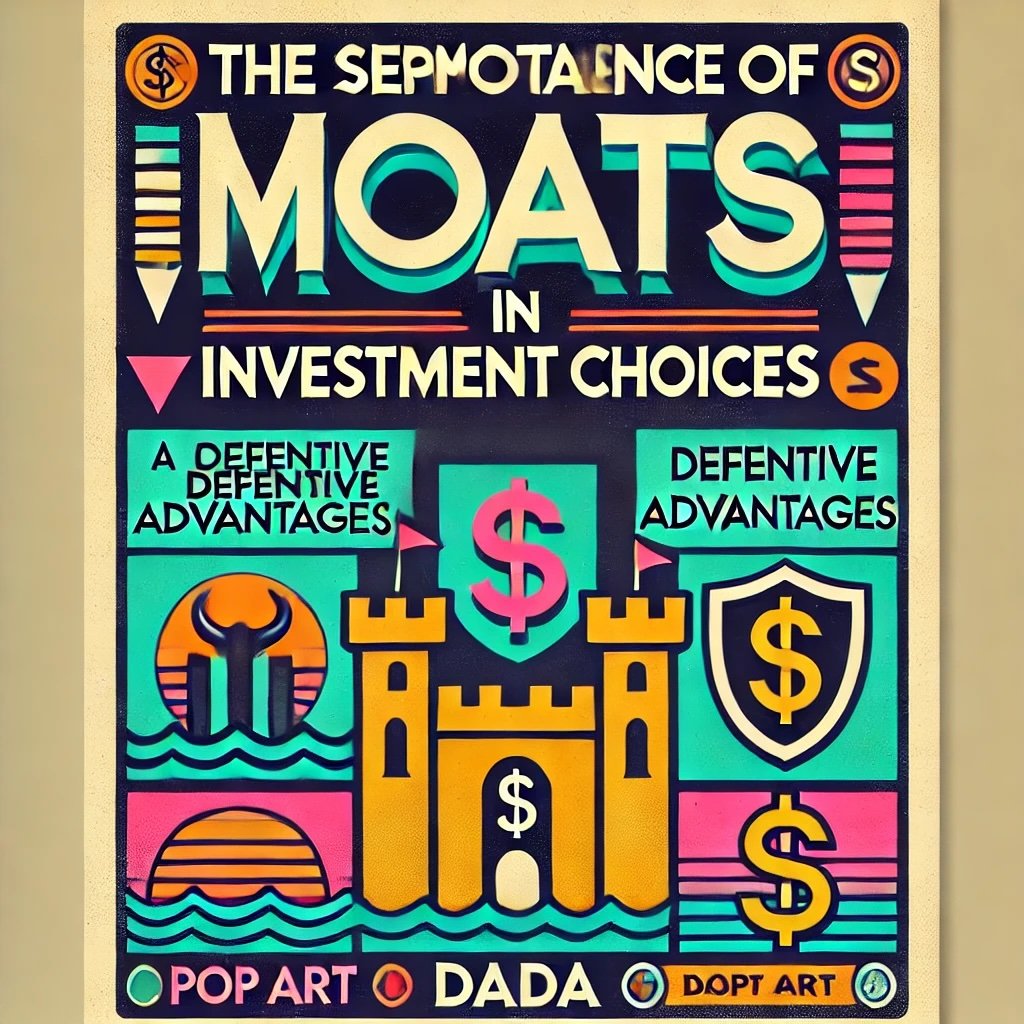
Buffett identifies several types of economic moats, each contributing to a company’s resilience in different ways. Brand recognition and loyalty create a strong emotional connection with customers, making it difficult for competitors to lure them away. Cost advantages, such as economies of scale or superior supply chain management, allow companies to produce goods or services more efficiently than others. Network effects occur when a product or service becomes more valuable as more people use it, creating a self-reinforcing cycle of growth. Intellectual property, like patents or proprietary technology, provides legal protection against imitation. By focusing on these various moats, Buffett ensures that his investments are not only profitable but also secure against market volatility and competitive threats.
Moreover, an economic moat isn’t just about surviving; it’s about thriving and expanding. Companies with wide moats often enjoy higher profit margins, greater pricing power, and increased customer retention. This translates to more robust financial health, allowing these businesses to reinvest in innovation, enter new markets, and adapt to changing consumer demands. Buffett’s emphasis on moats reflects his broader investment philosophy—prioritizing quality and sustainability over short-term gains. By choosing companies with enduring competitive advantages, he builds a portfolio that can weather economic downturns and capitalize on growth opportunities, ensuring long-term wealth accumulation.
- Competitive Advantages: Moats protect companies from competition, ensuring sustained profitability.
- Types of Moats: Includes brand loyalty, cost advantages, network effects, and intellectual property.
- Long-Term Stability: Companies with moats are better positioned to thrive in fluctuating markets.
Tip: When evaluating potential investments, assess the strength and sustainability of a company’s economic moat to determine its long-term viability and profitability.
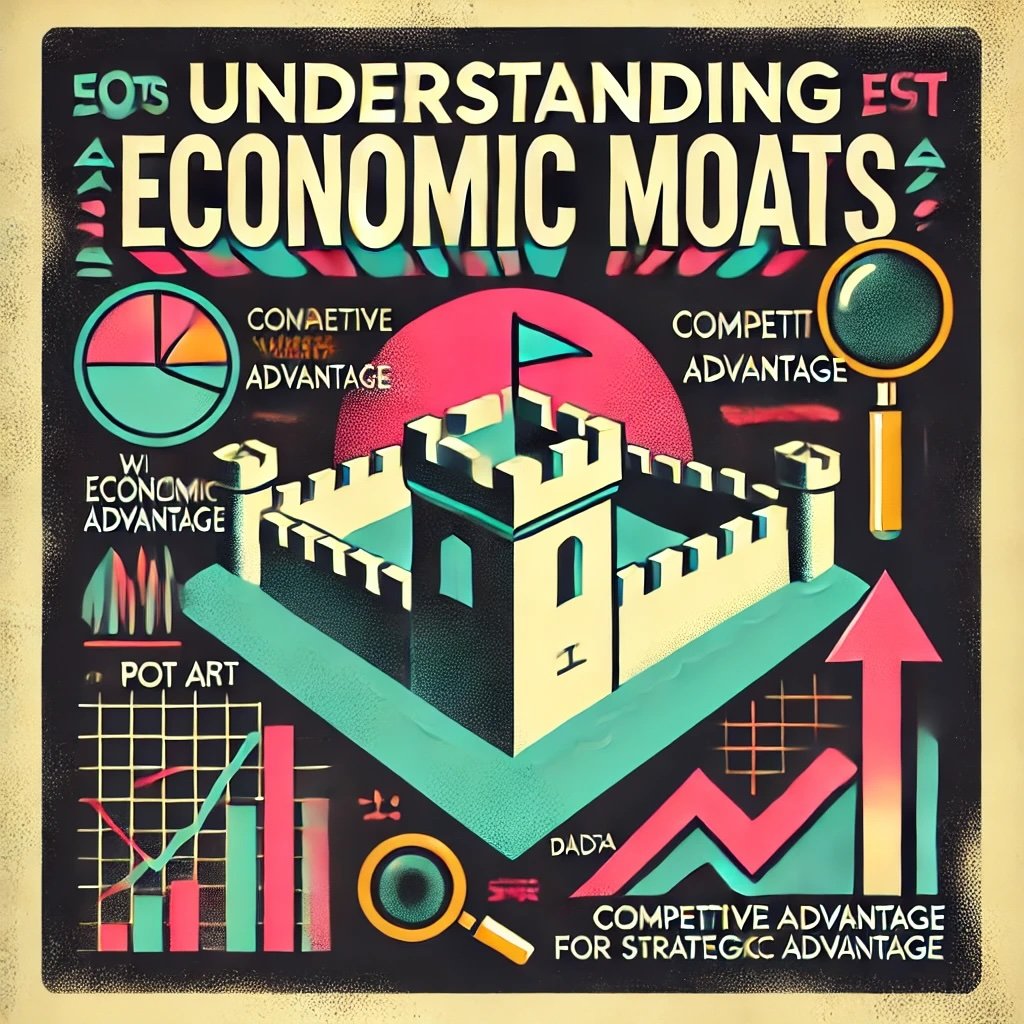
Understanding the Concept of an Economic Moat
So, why are economic moats so central to Warren Buffett’s investment strategy? We aim to unravel the significance of moats in Buffett’s decision-making process, shedding light on why he consistently prioritizes companies with strong competitive advantages. By understanding the role of economic moats, investors can gain valuable insights into building a resilient and profitable investment portfolio. Buffett’s focus on moats is not just a theoretical concept; it’s a practical approach that has proven successful time and again. This strategy helps mitigate risks, enhance returns, and ensure that investments remain robust even in volatile market conditions.
Furthermore, investing in companies with strong moats offers numerous benefits. These businesses typically exhibit higher profitability, better cash flow management, and greater ability to reinvest in their operations. They are also more likely to withstand economic downturns and competitive pressures, providing a safer harbor for investors during uncertain times. By highlighting the advantages of investing in moat-protected companies, the article underscores how this approach can lead to more stable and enduring wealth creation. Buffett’s methodology demonstrates that focusing on quality and sustainability can outperform short-term speculative strategies, offering a blueprint for long-term investment success.
Additionally, we’ll explore how economic moats contribute to a company’s intrinsic value. Buffett’s meticulous analysis of a company’s moat helps him determine its true worth, ensuring that he pays a fair price for his investments. This disciplined approach not only safeguards his capital but also enhances his ability to generate substantial returns over time. Understanding the interplay between moats and intrinsic value is key to appreciating Buffett’s investment genius. By aligning his investments with companies that possess enduring competitive advantages, he maximizes his potential for wealth accumulation while minimizing exposure to unnecessary risks.
Moreover, we highlight practical ways for investors to identify and evaluate economic moats. From analyzing financial statements to assessing market position and competitive landscape, these strategies equip readers with the tools needed to make informed investment decisions. By applying Buffett’s principles, individual investors can enhance their own investment strategies, focusing on companies that offer both growth potential and security. This comprehensive exploration of economic moats not only demystifies a core component of Buffett’s success but also empowers readers to adopt a more strategic and informed approach to their own investing endeavors.
- Central Strategy: Moats are key to Buffett’s successful and resilient investments.
- Investment Security: Companies with moats offer more predictable and stable returns.
- Portfolio Resilience: Strong moats contribute to a robust and enduring investment portfolio.
Tip: Incorporate an analysis of a company’s economic moat into your investment research to identify high-potential, resilient businesses that can weather market fluctuations.

Types of Economic Moats
Brand Recognition and Loyalty
How strong brands create customer loyalty and pricing power
A strong brand is one of the most potent economic moats a company can possess. When consumers recognize and trust a brand, they are more likely to remain loyal, even in the face of competition. Brand loyalty translates to significant pricing power, allowing companies to maintain higher margins without losing customers. This loyalty is built over time through consistent quality, excellent customer service, and effective marketing strategies. Warren Buffett understands that brands like Coca-Cola and Apple have enduring appeal, making them reliable investments with long-term profitability.
- Customer Loyalty: Strong brands ensure repeat business and customer retention.
- Pricing Power: Ability to charge premium prices without losing market share.
- Market Differentiation: Brands stand out in crowded markets, reducing direct competition.
Tip: Invest in companies with well-established brands that have a loyal customer base, as these businesses are more likely to sustain their competitive advantage over time.
Cost Advantages
Explanation of how lower costs can serve as a moat
Cost advantages are another critical type of economic moat that can shield a company from competitors. When a business can produce goods or services at a lower cost than its rivals, it gains a significant edge in the market. This cost leadership allows companies to offer lower prices to consumers or enjoy higher profit margins, both of which contribute to sustained financial health. Warren Buffett often looks for businesses with efficient operations and economies of scale, such as those in the manufacturing or retail sectors, where cost management is paramount. Companies like See’s Candies and Moody’s exemplify how cost advantages can lead to robust and enduring profitability.
- Economies of Scale: Lower per-unit costs as production increases, enhancing competitiveness.
- Operational Efficiency: Streamlined processes reduce waste and increase productivity.
- Barrier to Entry: High cost efficiency makes it difficult for new competitors to enter the market.
Tip: Evaluate a company’s cost structure and operational efficiency to determine if it has a sustainable cost advantage that can protect its market position.

Network Effects
Understanding network effects and their impact on market dominance
Network effects occur when the value of a product or service increases as more people use it, creating a self-reinforcing cycle of growth. This phenomenon can lead to market dominance, as new users are attracted to platforms that are already popular. Network effects are particularly powerful in technology and service-based industries, where the utility of a product is directly tied to its user base. Warren Buffett recognizes the strength of network effects in companies like Apple and Visa, where a large, engaged user base not only drives revenue but also creates significant barriers for competitors. These effects ensure that once a company reaches critical mass, it can maintain its competitive edge with ease.
- User Growth: More users attract even more users, creating exponential growth.
- Enhanced Value: Increased usage improves the overall value of the product or service.
- Competitive Barrier: Established networks make it difficult for new entrants to gain traction.
Tip: Look for companies where the product or service becomes more valuable as more people use it, as this can lead to sustained growth and market dominance.
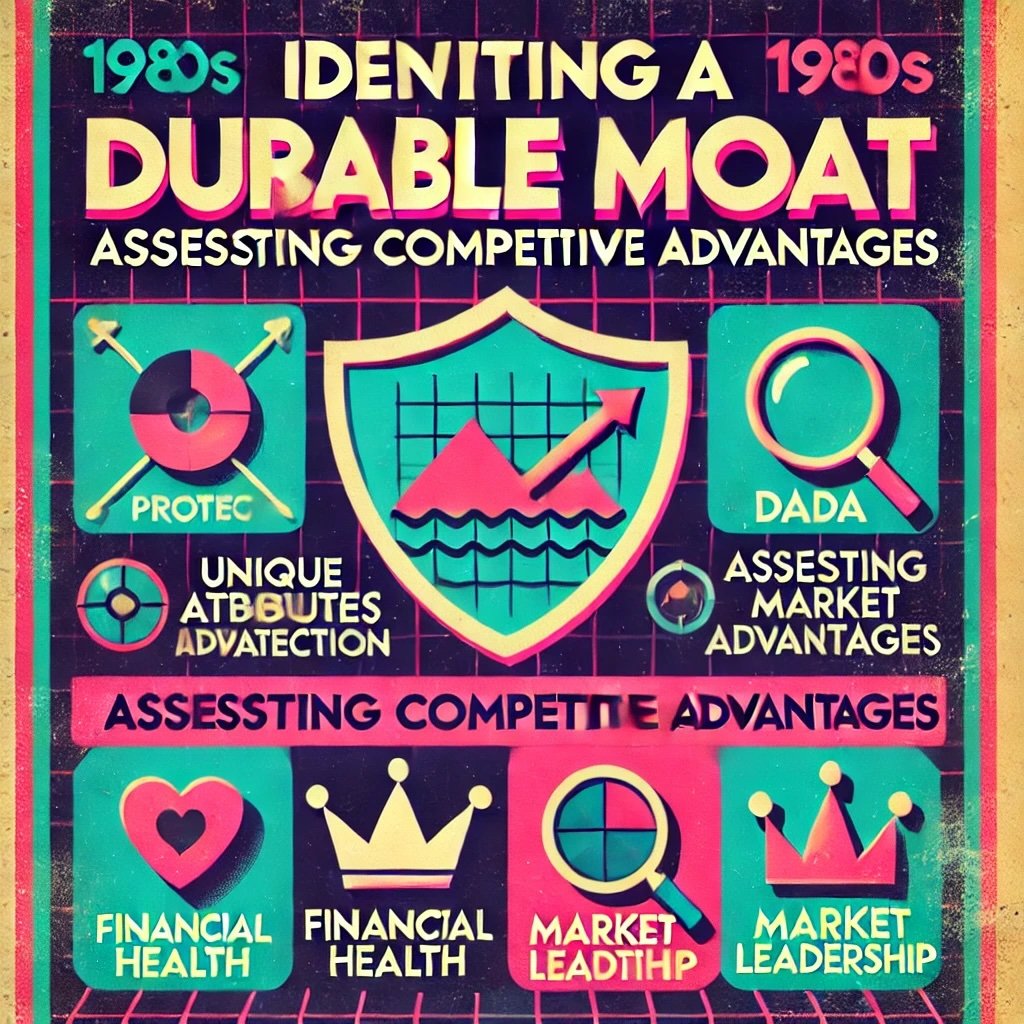
Identifying a Durable Moat
Assessing Competitive Advantages
Warren Buffett meticulously assesses a company’s competitive advantages to determine the strength and durability of its economic moat. He looks for businesses that possess unique attributes that set them apart from competitors, such as strong brand identity, proprietary technology, or exclusive access to resources. Buffett evaluates factors like market share, customer loyalty, and pricing power, ensuring that the company can maintain its edge over time. Additionally, he examines the company’s financial health, including consistent revenue growth, high return on equity, and robust profit margins, which are indicative of a sustainable competitive advantage. By using these criteria, Buffett can identify companies that not only have a moat but also the potential to protect it against future threats.
- Unique Attributes: Identifies features that differentiate the company from competitors.
- Financial Health: Assesses revenue growth, return on equity, and profit margins.
- Market Position: Evaluates market share and customer loyalty.
Tip: Use a combination of qualitative and quantitative metrics to thoroughly evaluate a company’s competitive advantages and ensure its moat is robust and sustainable.
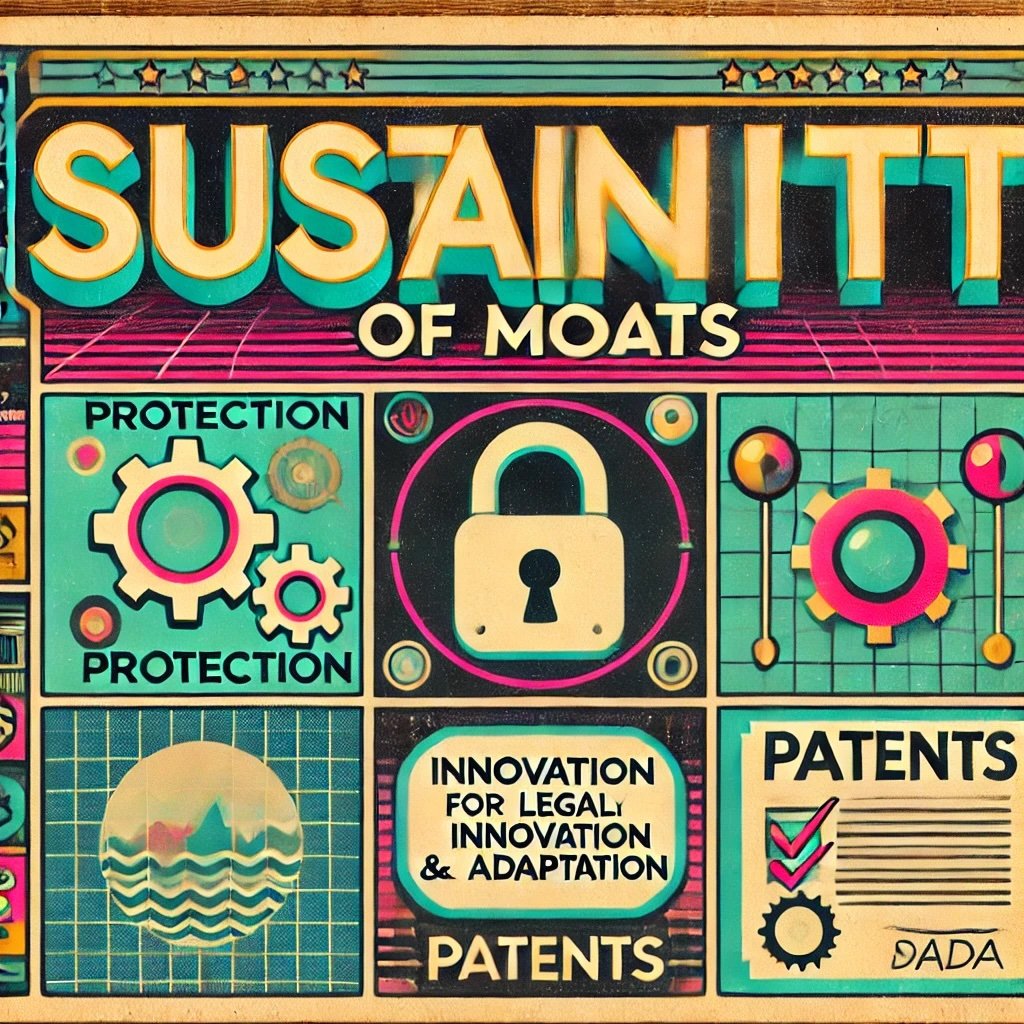
Sustainability of Moats
The sustainability of a moat is crucial for ensuring that a company’s competitive advantage remains intact over the long term. Buffett considers several factors that contribute to the longevity of a moat, including the company’s ability to innovate, adapt to market changes, and defend its position against new entrants. He assesses whether the company’s moat is protected by legal barriers, such as patents or trademarks, or by operational efficiencies that are hard to replicate. Additionally, Buffett looks at the industry landscape to determine if the moat can withstand technological advancements and shifting consumer preferences. By evaluating these elements, Buffett ensures that the companies he invests in can maintain their competitive edge despite evolving market conditions.
- Innovation and Adaptation: Determines if the company can evolve with changing markets.
- Legal Barriers: Considers patents, trademarks, and other protections.
- Industry Landscape: Analyzes the potential impact of new technologies and competitors.
Tip: Focus on companies that demonstrate a strong ability to innovate and adapt, ensuring their moats can endure future market dynamics and competitive pressures.
Real-World Examples
To illustrate how Buffett identifies and evaluates durable moats, let’s look at some real-world examples from his investment portfolio. Coca-Cola is a prime example, with its iconic brand and extensive global distribution network creating a powerful moat that ensures consistent consumer loyalty and pricing power. Another example is Apple, where its ecosystem of products and services, combined with strong brand loyalty, provides a significant competitive advantage that is difficult for rivals to replicate. Moody’s Corporation also stands out, benefiting from its established reputation and the critical role it plays in the financial industry, making it a trusted authority in credit ratings. These investments showcase Buffett’s ability to identify companies with strong, sustainable moats that can deliver long-term value and withstand competitive threats. From Coca-Cola’s brand strength to Apple’s innovative ecosystem, each example highlights the key elements that make a moat durable and impactful.
- Coca-Cola: Strong brand and global distribution network.
- Apple: Integrated ecosystem and loyal customer base.
- Moody’s Corporation: Established reputation and industry authority.
Tip: Study successful companies with enduring moats to understand the key elements that contribute to their sustained competitive advantages and apply these insights to your investment decisions.
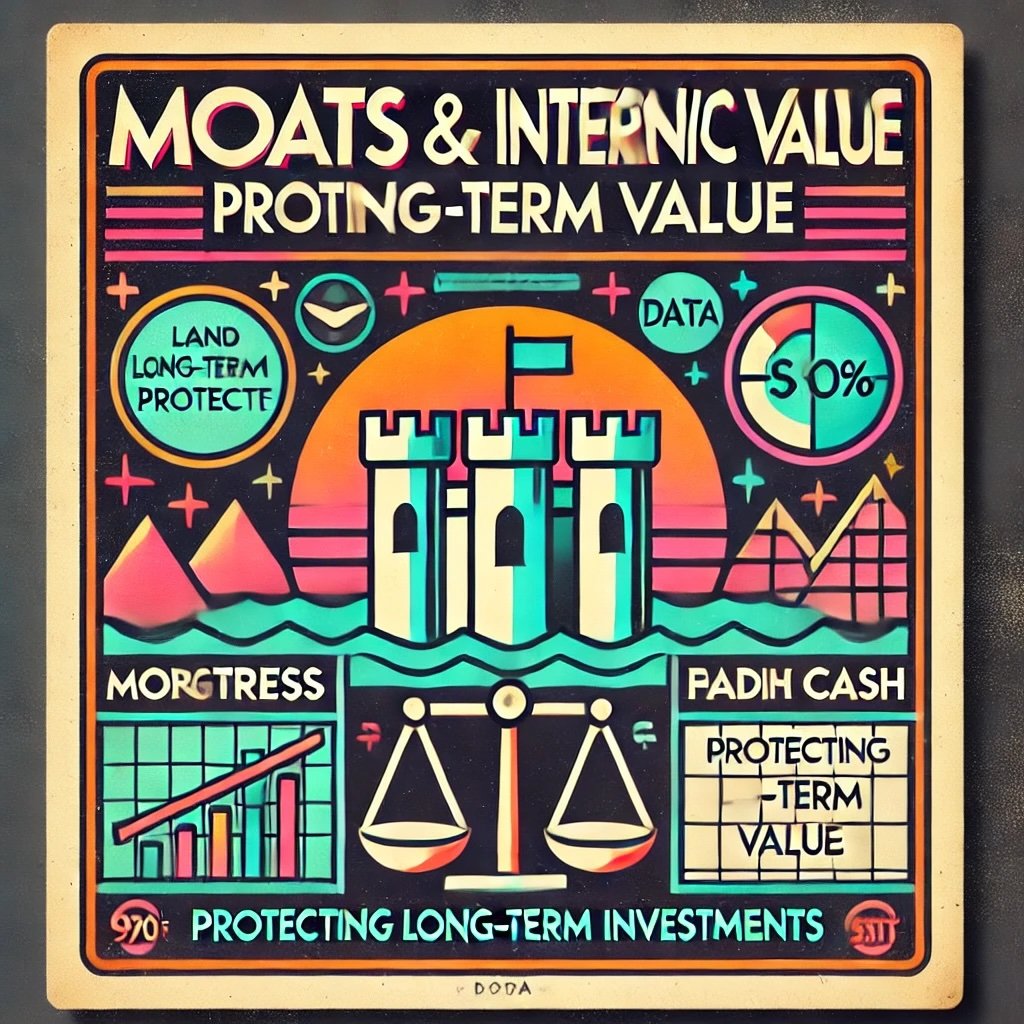
The Role of Moats in Valuation
Impact on Intrinsic Value
A strong economic moat significantly enhances a company’s intrinsic value, which is the true, inherent worth of a business based on its fundamentals. When a company possesses a robust moat, it can sustain higher profit margins, generate consistent cash flows, and maintain a competitive edge over its rivals. Warren Buffett meticulously assesses how these moats contribute to a company’s intrinsic value, ensuring that his investments are not only profitable but also resilient in the long run.
Buffett’s approach to valuing companies with significant moats involves a deep dive into their financial health and competitive positioning. He looks beyond surface-level metrics, examining factors such as return on equity (ROE), return on invested capital (ROIC), and free cash flow. These indicators help Buffett determine whether a company’s moat is translating into tangible financial performance. For instance, a company with a strong brand may enjoy premium pricing and customer loyalty, leading to sustained revenue growth and profitability, thereby increasing its intrinsic value.
Moreover, Buffett emphasizes the importance of understanding a company’s business model and how its moat protects it from competition. This comprehensive analysis allows him to accurately estimate the future cash flows and growth potential of the business. By integrating the strength of a company’s moat into his valuation models, Buffett ensures that he pays a fair price for his investments, aligning the purchase price with the company’s intrinsic value. This disciplined approach minimizes the risk of overpaying and maximizes the potential for long-term gains.
- Sustained Profit Margins: Companies with strong moats can maintain higher profit margins.
- Consistent Cash Flows: Reliable cash generation supports intrinsic value growth.
- Competitive Edge: Moats provide a buffer against market volatility and competition.
Tip: When valuing a company, incorporate the strength and sustainability of its economic moat to better estimate its true intrinsic value and ensure a sound investment decision.
Margin of Safety
The margin of safety is a fundamental concept in Warren Buffett’s investment philosophy, especially in relation to companies with economic moats. It refers to the difference between a company’s intrinsic value and its current market price. By investing with a margin of safety, Buffett minimizes the risk of loss and maximizes potential returns. Companies with strong moats inherently offer a larger margin of safety, as their competitive advantages make them less vulnerable to economic downturns and competitive threats.
Buffett uses the concept of a margin of safety to determine the level of risk associated with an investment. A wide margin of safety provides a cushion against unforeseen negative events, ensuring that even if the company’s performance falters, the investment remains relatively secure. For example, if a company’s intrinsic value is estimated at $100 per share, Buffett might only be willing to pay $70 per share, allowing for a 30% margin of safety. This approach ensures that he is buying undervalued stocks with strong moats, reducing the likelihood of significant losses.
Additionally, Buffett leverages moats to enhance the margin of safety. A durable moat means that the company can sustain its competitive advantages over time, protecting its intrinsic value from erosion. This durability not only preserves the company’s profitability but also provides Buffett with confidence that his investment is well-protected. By combining a strong economic moat with a substantial margin of safety, Buffett creates a robust framework for risk management and value investing.
- Risk Minimization: A larger margin of safety reduces the potential for investment losses.
- Confidence in Investments: Strong moats provide assurance that the company’s value is protected.
- Long-Term Security: Ensures investments can withstand market fluctuations and economic downturns.
Tip: Always seek a margin of safety in your investments by purchasing stocks below their intrinsic value, especially when investing in companies with strong economic moats.
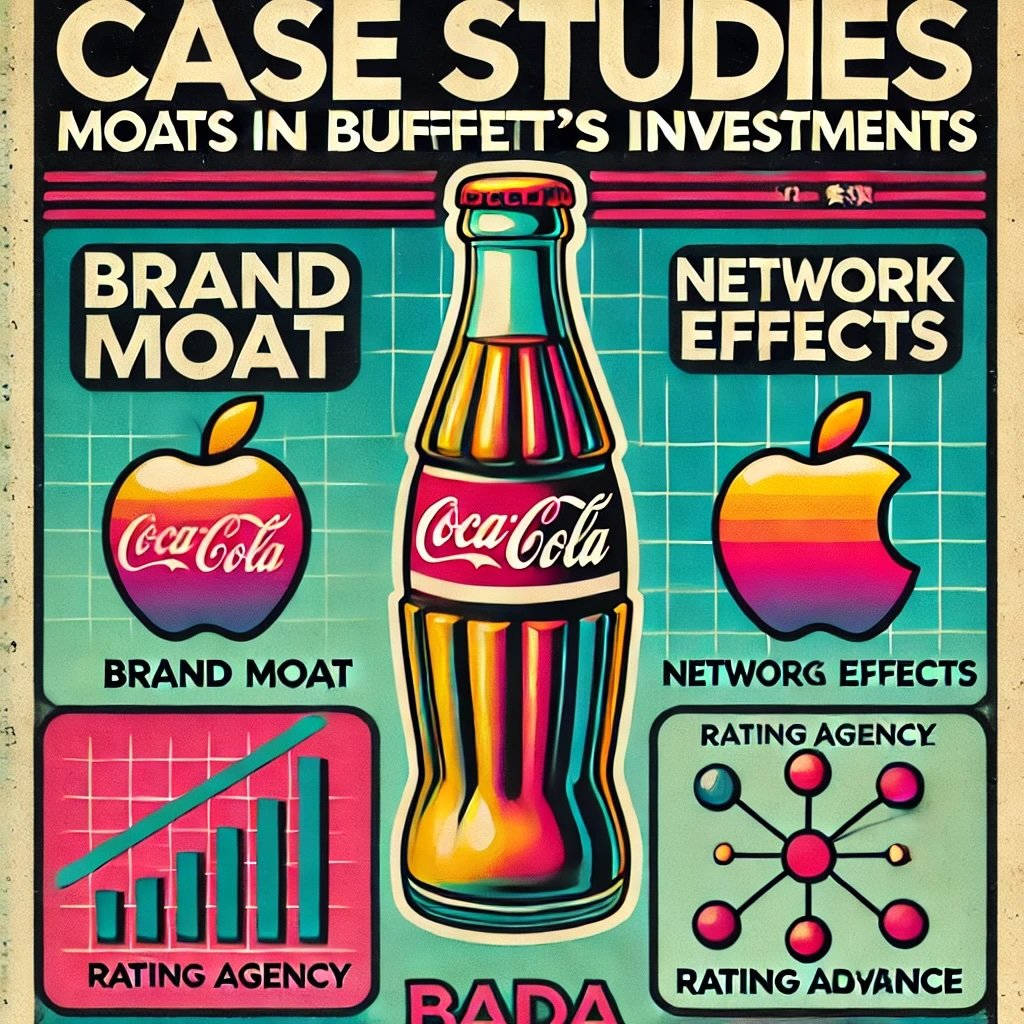
Case Studies
To illustrate the pivotal role moats play in Warren Buffett’s valuation process, let’s examine a few real-world examples from his investment portfolio. These case studies highlight how Buffett identifies, evaluates, and leverages economic moats to achieve substantial returns.
Coca-Cola is a quintessential example of a company with a strong brand moat. Buffett recognized Coca-Cola’s global brand recognition and customer loyalty as key factors that would sustain its market dominance. Despite the competitive beverage industry, Coca-Cola’s ability to maintain high profit margins and consistent sales growth exemplifies the power of a robust brand moat. Buffett’s investment in Coca-Cola has yielded significant returns, demonstrating how a strong brand can drive long-term value and stability.
Another notable case is Apple Inc., where network effects create a formidable moat. Apple’s ecosystem of interconnected products and services—such as the iPhone, iPad, Mac, and Apple Music—enhances customer loyalty and makes it difficult for competitors to lure users away. Buffett’s investment in Apple capitalizes on these network effects, ensuring that the company remains a dominant force in the tech industry. The seamless integration of Apple’s products fosters a loyal customer base, driving consistent revenue growth and reinforcing the company’s intrinsic value.
Moody’s Corporation offers an example of a cost advantage moat. As a leading credit rating agency, Moody’s benefits from its established reputation and expertise, which create high barriers to entry for new competitors. Buffett’s investment in Moody’s underscores the importance of operating in a niche where expertise and reputation provide a significant competitive edge. This cost advantage ensures that Moody’s can maintain its market position and profitability, making it a valuable addition to Buffett’s portfolio.
- Coca-Cola: Strong brand and global presence driving consistent profitability.
- Apple Inc.: Network effects creating a loyal customer ecosystem.
- Moody’s Corporation: Cost advantages through established expertise and reputation.
Tip: Analyze successful investments to understand how different types of economic moats contribute to a company’s sustained competitive advantage and intrinsic value.
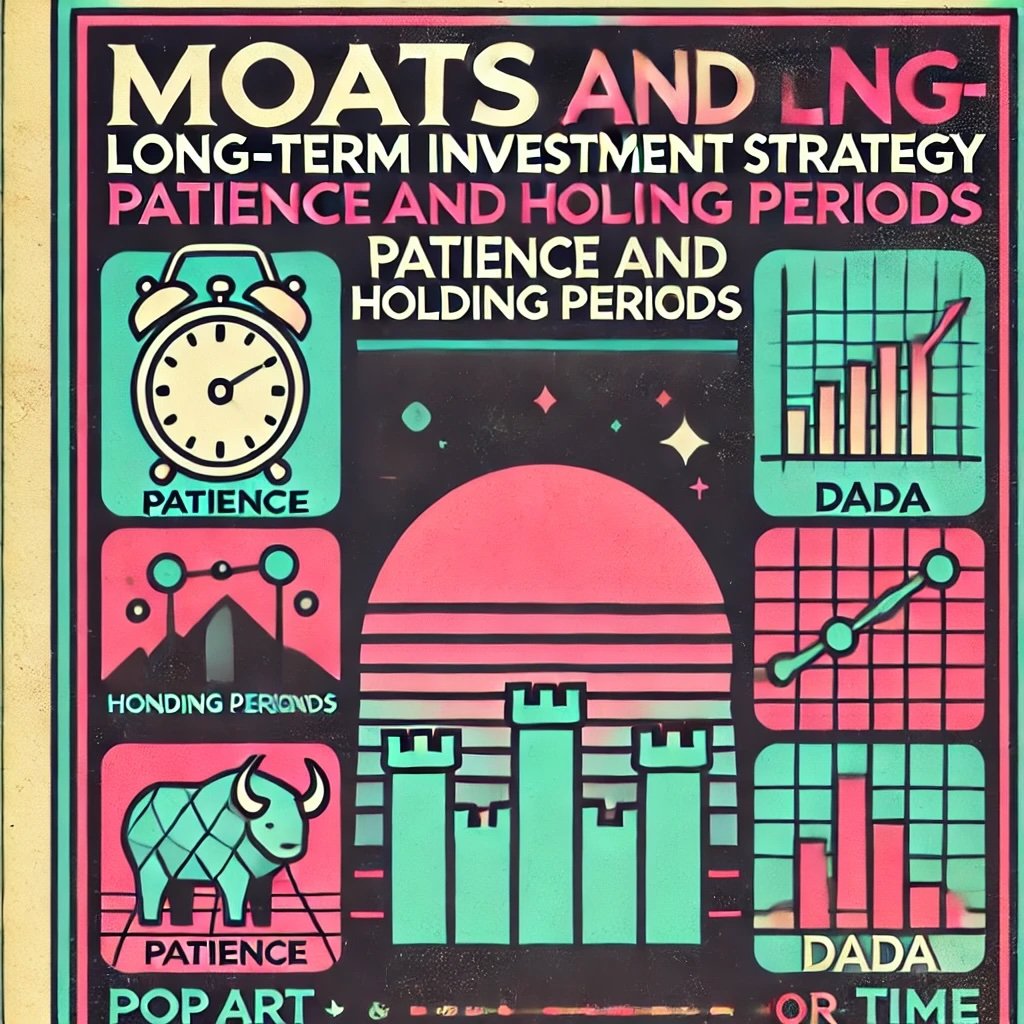
Moats and Long-Term Investment Strategy
Patience and Holding Periods
The Importance of Patience in Maintaining Investments in Moat-Protected Companies
One of the hallmarks of Warren Buffett’s investment strategy is his unwavering patience. In the fast-paced world of investing, where short-term gains often take center stage, Buffett stands out by championing the virtue of patience, especially when it comes to moat-protected companies. Patience allows investors to ride out market volatility, giving their investments the time they need to realize their full potential. This long-term perspective is crucial for companies with strong economic moats, as their competitive advantages typically yield significant returns over extended periods.
Buffett believes that holding onto high-quality companies for the long haul not only maximizes the benefits of their moats but also compounds returns over time. By staying invested, he ensures that the intrinsic value of these companies grows alongside their market presence and profitability. This approach contrasts sharply with the reactive strategies of frequent trading, which can often lead to missed opportunities and diminished returns. Buffett’s patience is a testament to his confidence in the enduring power of economic moats, allowing him to benefit from sustained growth and resilience against competitive pressures.
- Ride Out Volatility: Patience helps investors withstand market fluctuations and downturns.
- Maximize Moat Benefits: Long-term holding allows companies to fully leverage their competitive advantages.
- Compound Returns: Time in the market enhances the power of compound interest and reinvested earnings.
Tip: Adopt a long-term mindset when investing in companies with strong moats, allowing your investments to grow and capitalize on sustained competitive advantages.
How Long-Term Holding Enhances the Benefits of a Company’s Moat
Holding investments over the long term amplifies the benefits of a company’s moat by allowing it to continuously reinforce its competitive advantages. As market conditions evolve, companies with durable moats can adapt and innovate, further solidifying their market position. Buffett’s strategy involves selecting companies that not only have strong moats today but also demonstrate the potential to maintain and even expand those moats in the future. This forward-thinking approach ensures that the companies remain leaders in their industries, providing consistent returns to investors.
For example, Apple’s ecosystem is a prime illustration of how long-term holding enhances a moat. By continually expanding its range of products and services, Apple deepens customer loyalty and increases the stickiness of its ecosystem. Buffett’s patience allows him to benefit from the compounding growth of such innovations, ensuring that the intrinsic value of his investment appreciates over time. This sustained growth is only possible through a commitment to long-term holding, which enables the company to capitalize on its competitive strengths fully.
Moreover, long-term holding reduces the impact of short-term market noise, allowing investors to focus on the fundamental performance of the business. Buffett’s approach ensures that he remains invested in companies that consistently demonstrate strong financial health and strategic positioning, rather than being swayed by temporary market sentiments or speculative trends. This disciplined holding strategy not only enhances the benefits of the company’s moat but also fosters a more stable and predictable investment outcome.
- Continuous Reinforcement: Companies can further strengthen their moats over time.
- Adaptation and Innovation: Long-term holding allows companies to innovate and stay ahead of competitors.
- Focus on Fundamentals: Reduces the influence of short-term market fluctuations on investment decisions.
Tip: Focus on the long-term potential of a company’s moat, allowing it to evolve and strengthen, thereby increasing the value of your investment over time.
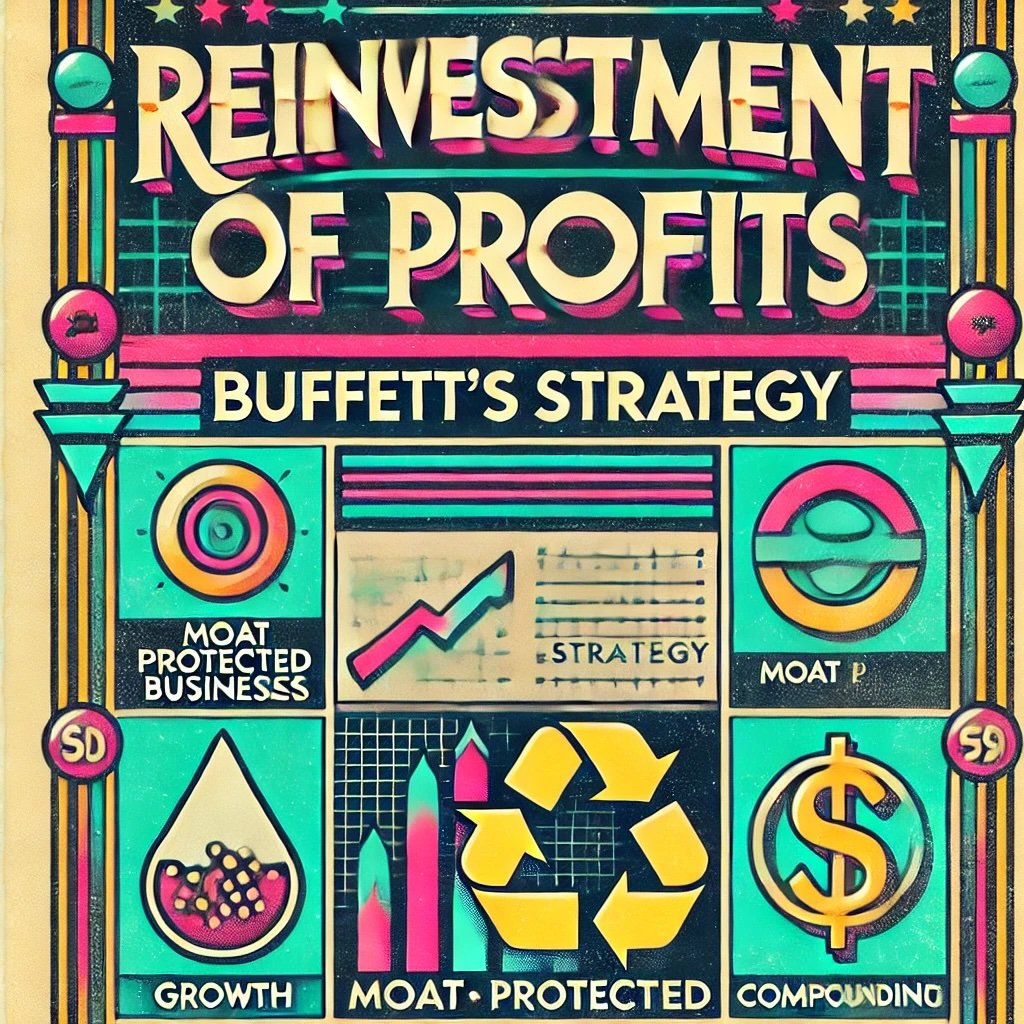
Reinvestment of Profits
Buffett’s Strategy for Reinvesting Profits from Moat-Protected Businesses
Warren Buffett’s strategy for reinvesting profits from moat-protected businesses is a key component of his long-term investment success. Instead of distributing profits to shareholders, Buffett often opts to reinvest those earnings back into the business or other high-quality investments. This approach not only fuels the growth of the companies he invests in but also leverages the power of compound interest, significantly enhancing overall returns over time.
Buffett’s focus on capital allocation ensures that profits are directed towards areas that promise the highest returns. Whether it’s expanding existing operations, acquiring complementary businesses, or investing in new ventures, Buffett’s reinvestment strategy is always aligned with the company’s ability to maintain and enhance its economic moat. By continually funneling profits into strategic initiatives, he ensures that the company remains competitive and capable of sustaining its market dominance.
For instance, Berkshire Hathaway’s investments in companies like Apple and Coca-Cola demonstrate how reinvesting profits can lead to exponential growth. Apple’s consistent reinvestment in research and development has resulted in innovative products and services that further strengthen its ecosystem, thereby enhancing its moat. Similarly, Coca-Cola’s reinvestment in marketing and distribution ensures that its brand remains strong and its market presence is expansive. Buffett’s disciplined reinvestment approach not only sustains the company’s competitive advantages but also drives continuous value creation for shareholders.
- Fuel Growth: Reinvested profits drive the expansion and enhancement of the company’s operations.
- Compound Interest: Reinvesting earnings maximizes the power of compounding over time.
- Strategic Allocation: Directs profits towards high-return initiatives that reinforce moats.
Tip: Reinvest profits from your investments into opportunities that can further enhance their competitive advantages, maximizing long-term returns through the power of compounding.
The Compounding Effect of Reinvested Earnings in Sustaining and Expanding Moats
The compounding effect of reinvested earnings is a powerful force in sustaining and expanding a company’s moat. When profits are reinvested wisely, they generate additional returns, which can then be reinvested again, creating a snowball effect that significantly enhances the company’s financial strength and market position over time. Buffett’s focus on reinvesting earnings ensures that his investments grow exponentially, as each cycle of reinvestment builds upon the last, reinforcing the company’s competitive advantages.
For example, Berkshire Hathaway’s investment in Coca-Cola showcases the compounding effect of reinvested earnings. The continuous reinvestment in marketing and global distribution channels not only maintains Coca-Cola’s brand strength but also expands its reach into new markets. This ongoing investment allows Coca-Cola to capture a larger market share, further solidifying its economic moat and driving sustained revenue growth. As the company’s profits grow, so does its ability to reinvest in strategic initiatives, ensuring that the moat remains robust and continues to provide a competitive edge.
Additionally, the compounding effect of reinvested earnings enables companies to innovate and adapt, keeping their moats strong in the face of evolving market dynamics. Buffett’s strategy ensures that moat-protected businesses can invest in new technologies, expand their product lines, and explore new markets, thereby enhancing their resilience and long-term profitability. This sustainable growth model not only benefits the company but also creates substantial value for investors, who reap the rewards of compounded returns over time.
- Exponential Growth: Reinvested earnings lead to continuous and accelerated growth.
- Market Expansion: Compounding profits enable expansion into new markets and segments.
- Innovation and Adaptation: Sustains the company’s ability to innovate and stay ahead of competitors.
Tip: Leverage the compounding effect by consistently reinvesting profits into your investments, allowing them to grow and strengthen their competitive advantages over time.
Adapting to Changes
How Buffett Monitors and Adapts to Changes in a Company’s Moat
While economic moats provide a strong foundation for a company’s success, the business landscape is constantly evolving, necessitating continual monitoring and adaptation to maintain and strengthen these moats. Warren Buffett understands that even the most robust moats can erode over time due to technological advancements, changing consumer preferences, or new competitors. Therefore, he remains vigilant in assessing the durability of a company’s moat, ensuring that it can withstand market shifts and competitive pressures.
Buffett employs a proactive approach to monitoring changes in a company’s moat, regularly reviewing financial performance, market trends, and competitive dynamics. He looks for signs that a company is maintaining its competitive edge, such as ongoing investments in innovation, expansion into new markets, or enhancements in operational efficiency. If he notices any signs of moat erosion, Buffett is prepared to reassess his investment and consider alternative opportunities that better align with his investment criteria.
Moreover, Buffett’s adaptability extends to his willingness to divest from companies whose moats are weakening. He believes in the importance of reallocating capital to businesses that continue to demonstrate strong competitive advantages, ensuring that his investment portfolio remains robust and aligned with his long-term strategy. This flexibility allows Buffett to protect his investments from declining moats, minimizing potential losses and preserving capital for future opportunities.
- Continuous Monitoring: Regularly assess the strength and sustainability of a company’s moat.
- Proactive Adaptation: Make strategic adjustments based on changing market conditions.
- Capital Reallocation: Divest from weakening moats and reinvest in stronger opportunities.
Tip: Stay informed about industry trends and continuously evaluate the strength of a company’s moat to ensure your investments remain resilient and competitive.
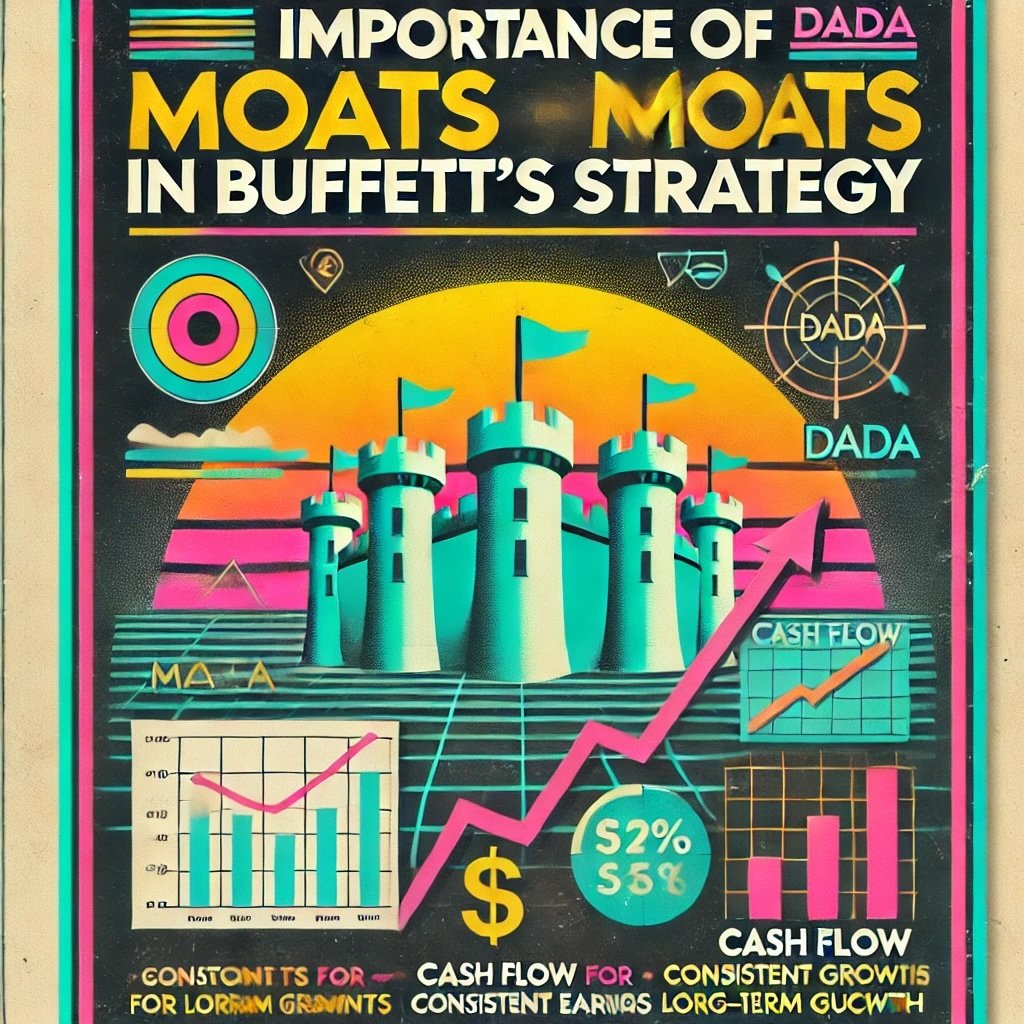
Importance of Moats in Buffett’s Strategy
Throughout his illustrious career, Warren Buffett has consistently demonstrated that economic moats are fundamental to his investment success. Moats—whether they stem from strong brand recognition, cost advantages, or network effects—provide companies with the resilience needed to thrive amidst fierce competition and market volatility. By focusing on businesses with durable moats, Buffett ensures that his investments are not only profitable but also sustainable over the long term.
Buffett’s emphasis on economic moats contributes significantly to building a resilient investment portfolio. Companies with robust moats are better equipped to maintain their market position, generate consistent cash flows, and withstand economic downturns. This stability translates into lower risk and more predictable returns, aligning perfectly with Buffett’s value investing philosophy. By prioritizing moats, Buffett safeguards his investments against competitive threats, ensuring that his portfolio remains strong even when market conditions are unfavorable.
Moreover, the critical role of economic moats in Buffett’s strategy lies in their ability to enhance intrinsic value. Strong moats enable companies to achieve higher profitability, foster innovation, and expand their market reach, all of which contribute to an increase in intrinsic value over time. This strategic focus allows Buffett to identify and invest in businesses that not only possess immediate competitive advantages but also have the potential for long-term growth and success. As a result, his investment portfolio is characterized by stability, growth, and enduring value.
- Resilience Against Competition: Moats protect companies from rivals, ensuring sustained market dominance.
- Consistent Cash Flows: Reliable earnings from moat-protected businesses enhance portfolio stability.
- Long-Term Growth: Moats facilitate ongoing innovation and market expansion, driving intrinsic value.
Tip: When building your investment portfolio, prioritize companies with strong economic moats to ensure long-term stability and growth.
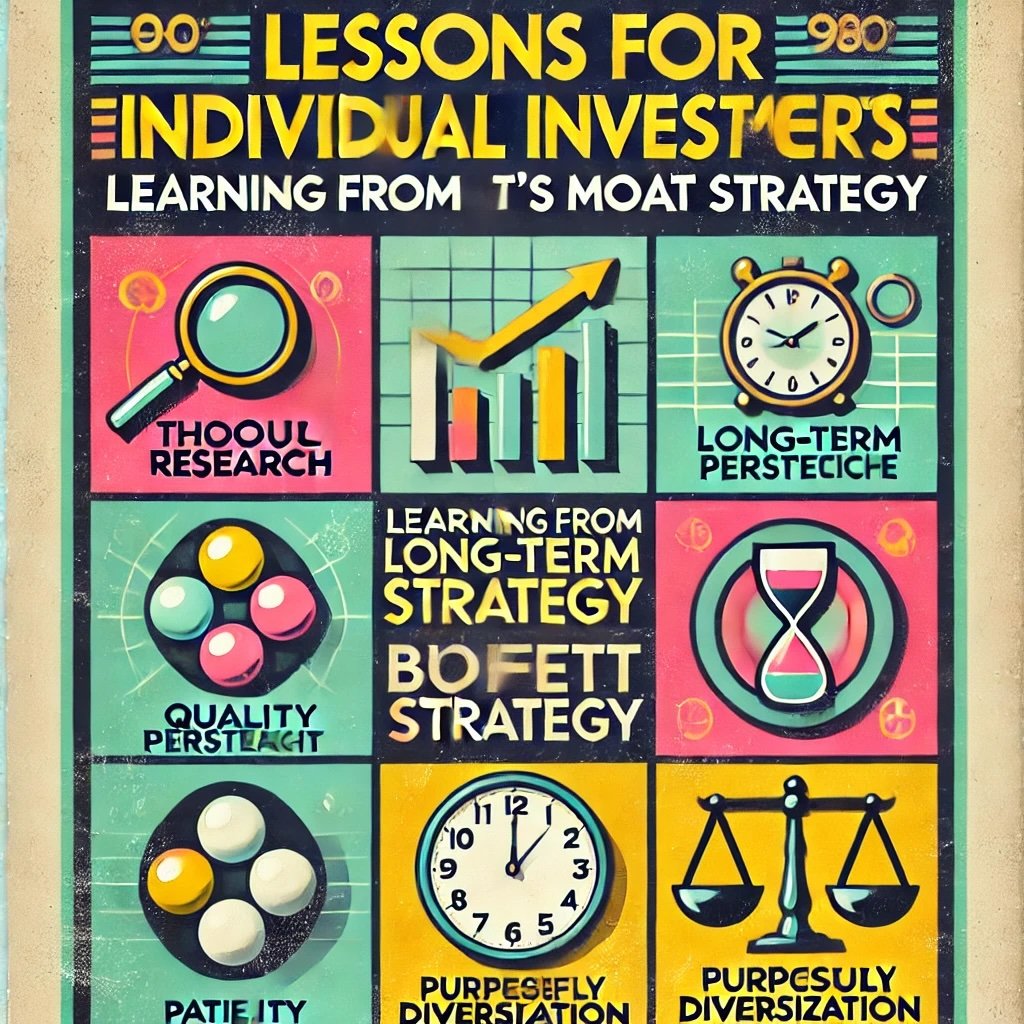
Lessons for Individual Investors
Warren Buffett’s focus on economic moats offers several valuable lessons for individual investors looking to emulate his success. Understanding and identifying moats can significantly enhance your investment strategy, providing a framework for selecting businesses that are poised for sustained success.
Key takeaways from Buffett’s emphasis on moats include:
- Prioritize Quality Over Quantity: Instead of spreading your investments thin across numerous companies, focus on a select few with strong competitive advantages. Quality investments with durable moats are more likely to yield consistent returns.
- Conduct Thorough Research: Buffett’s meticulous analysis of a company’s fundamentals ensures that he invests in businesses with genuine competitive strengths. As an investor, take the time to understand what makes a company unique and how it maintains its market position.
- Long-Term Perspective: Patience is crucial. Buffett’s strategy involves holding onto investments for the long haul, allowing moats to fully realize their potential. Avoid the temptation of short-term gains and focus on the long-term growth and stability of your investments.
- Diversify with Purpose: While Buffett emphasizes quality, he also ensures that his portfolio is diversified across different industries and types of moats. This strategic diversification mitigates risk and enhances the overall resilience of your investment portfolio.
- Adaptability and Vigilance: Regularly assess the strength of a company’s moat and be prepared to adapt your investment strategy if necessary. Market conditions change, and it’s important to ensure that your investments continue to meet your criteria for competitive advantages.
By integrating these lessons into your investment approach, you can build a portfolio that mirrors Buffett’s success, characterized by strong, resilient businesses that offer long-term value.
- Focus on Quality: Invest in fewer, higher-quality companies with strong moats.
- Thorough Due Diligence: Understand the competitive advantages of each investment.
- Long-Term Holding: Allow time for moats to generate sustained returns.
- Strategic Diversification: Spread investments across various industries with different moats.
- Continuous Evaluation: Monitor and reassess the strength of moats over time.
Tip: Develop a disciplined investment strategy that prioritizes quality, conducts thorough research, and maintains a long-term perspective to emulate Buffett’s success.
Important Information
Comprehensive Investment Disclaimer:
All content provided on this website (including but not limited to portfolio ideas, fund analyses, investment strategies, commentary on market conditions, and discussions regarding leverage) is strictly for educational, informational, and illustrative purposes only. The information does not constitute financial, investment, tax, accounting, or legal advice. Opinions, strategies, and ideas presented herein represent personal perspectives, are based on independent research and publicly available information, and do not necessarily reflect the views or official positions of any third-party organizations, institutions, or affiliates.
Investing in financial markets inherently carries substantial risks, including but not limited to market volatility, economic uncertainties, geopolitical developments, and liquidity risks. You must be fully aware that there is always the potential for partial or total loss of your principal investment. Additionally, the use of leverage or leveraged financial products significantly increases risk exposure by amplifying both potential gains and potential losses, and thus is not appropriate or advisable for all investors. Using leverage may result in losing more than your initial invested capital, incurring margin calls, experiencing substantial interest costs, or suffering severe financial distress.
Past performance indicators, including historical data, backtesting results, and hypothetical scenarios, should never be viewed as guarantees or reliable predictions of future performance. Any examples provided are purely hypothetical and intended only for illustration purposes. Performance benchmarks, such as market indexes mentioned on this site, are theoretical and are not directly investable. While diligent efforts are made to provide accurate and current information, “Picture Perfect Portfolios” does not warrant, represent, or guarantee the accuracy, completeness, or timeliness of any information provided. Errors, inaccuracies, or outdated information may exist.
Users of this website are strongly encouraged to independently verify all information, conduct comprehensive research and due diligence, and engage with qualified financial, investment, tax, or legal professionals before making any investment or financial decisions. The responsibility for making informed investment decisions rests entirely with the individual. “Picture Perfect Portfolios” explicitly disclaims all liability for any direct, indirect, incidental, special, consequential, or other losses or damages incurred, financial or otherwise, arising out of reliance upon, or use of, any content or information presented on this website.
By accessing, reading, and utilizing the content on this website, you expressly acknowledge, understand, accept, and agree to abide by these terms and conditions. Please consult the full and detailed disclaimer available elsewhere on this website for further clarification and additional important disclosures. Read the complete disclaimer here.

